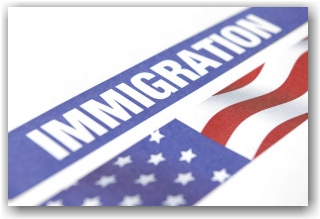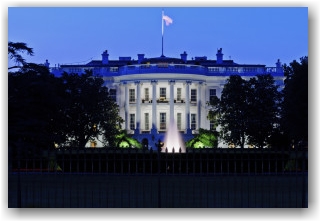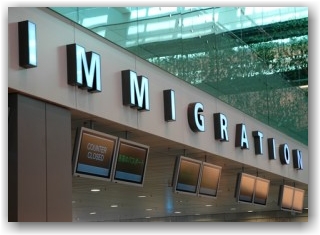Posts Tagged ‘H-1B’
Friday, February 5th, 2021
The initial registration period for FY 2022 will open at noon Eastern Time (ET) on March 9 and run through noon ET on March 25. Both representatives and registrants must wait until March 9 to create and complete H-1B registrations.
The electronic registration process has streamlined processing by reducing paperwork and data exchange, and has provided overall cost savings to employers seeking to file H-1B cap-subject petitions.
Under this process, prospective petitioners (also known as registrants), and their authorized representatives, who are seeking authorization to employ H-1B workers subject to the cap, complete a registration process that requires only basic information about the prospective petitioner and each requested worker. We will open an initial registration period for a minimum of 14 calendar days each fiscal year.The H-1B selection process will then be run on properly submitted electronic registrations. Only those with selected registrations will be eligible to file H-1B cap-subject petitions.
Please refer here for more information.
Our office is available to assist you with your case filing strategy and case submissions. We are already in planning mode. We can be contacted at info@immigrationcompliancegroup.com
Tags: H-1B, Specialty Occupation
Posted in Uncategorized | Comments Off on The H-1B Electronic Registration Process for Fiscal Year 2022
Monday, November 21st, 2016
 The long-awaited final rule to modernize and improve several aspects of employment-based nonimmigrant and immigrant visa programs, in order to retain EB-1, EB-2 and EB-3 immigrant workers and high-skilled nonimmigrant workers, is moving forward and has made it through the OMB review process. It was published in the Federal Register on November 18, 2016 and will be effective in 60 days. USCIS has also amended regulations to better enable U.S. employers to hire and retain certain foreign workers who are beneficiaries of approved employment-based immigrant visa petitions and are waiting to become lawful permanent residents. This rule goes into effect on Jan. 17, 2017, just before President Obama leaves office.
The long-awaited final rule to modernize and improve several aspects of employment-based nonimmigrant and immigrant visa programs, in order to retain EB-1, EB-2 and EB-3 immigrant workers and high-skilled nonimmigrant workers, is moving forward and has made it through the OMB review process. It was published in the Federal Register on November 18, 2016 and will be effective in 60 days. USCIS has also amended regulations to better enable U.S. employers to hire and retain certain foreign workers who are beneficiaries of approved employment-based immigrant visa petitions and are waiting to become lawful permanent residents. This rule goes into effect on Jan. 17, 2017, just before President Obama leaves office.
Among other things, DHS is amending its regulations to:
- Clarifies and improves longstanding DHS policies and practices implementing sections of the American Competitiveness in the Twenty-First Century Act and the American Competitiveness and Workforce Improvement Act related to certain foreign workers, which will enhance USCIS’ consistency in adjudication.
- Better enables U.S. employers to employ and retain high-skilled workers who are beneficiaries of approved employment-based immigrant visa petitions (Form I-140 petitions) while also providing stability and job flexibility to these workers. The rule increases the ability of these workers to further their careers by accepting promotions, changing positions with current employers, changing employers and pursuing other employment opportunities. This means that you can use the previous employer’s I-140 petition to extend your H-1B with a new employer even if it is withdrawn (as long as it was withdrawn more than 180 days after approval), or in the event of the termination of the employer’s business. So, there is no I-140 portability; you will still need a new labor certification and I-140 petition to file your adjustment of status application.
- The final rule provides two grace periods of up to 10 days, consistent with those already available to individuals in 13 some nonimmigrant classifications, to individuals in the E-1, E-2, E-3, L-1, and TN classifications. The rule allows an initial grace period of up to 10 days prior to the start of an authorized validity period, allowing nonimmigrants in the above classifications a reasonable amount of time to enter the US and prepare to begin employment. The rule also allows a second grace period of up to 10 days after the end of an authorized validity period, which provides a reasonable amount of time to depart the US or take other actions to extend, change, or maintain lawful status.
- Establishes a grace period of up to 60 consecutive days during each authorized validity period for certain high-skilled nonimmigrant workers when their employment ends before the end of their authorized validity period provided their authorized stay is valid for at least 60 days after such cessation. If not, the grace period will end on the date the authorized date is set to expire. This will obviously enable own to more readily pursue new employment and an extension of their nonimmigrant status.
- The Final rule allows allows certain high-skilled individuals in the United States to apply for work authorization, given:
- They are the principal beneficiaries of an approved Form I-140 petition,
- An immigrant visa is not authorized for issuance for their priority date, and
- They can demonstrate compelling circumstances exist that justify DHS issuing an employment authorization document in its discretion. Such employment authorization may only be renewed in limited circumstances and only in one year increments.
- Automatically extends the employment authorization in the same category and validity of Employment Authorization Documents for up to 180 days from the date of the prior EAD’s expiry (EADs or Form I-766’s) or until djudication of the EAD nrenewal application, for certain individuals who apply on time to renew their EADs. The Form I-9 rule is also updated to permit an I-797 receipt notice to be accepted as a permissible I-9 document, in conjunction with the expired EAD, to re-verify the foreign national’s work authorization. This additional 180-day period will not apply to those categories that first require the approval of an underlying application before the EAD renewal can be adjudicated.
- Eliminates the regulatory provision that requires USCIS to adjudicate the Form I-765, Application for Employment Authorization, within 90 days of filing and that authorizes interim EADs in cases where such adjudications are not conducted within the 90-day timeframe.
- Clarifies various policies and procedures related to the adjudication of H-1B petitions, including, among other things, providing H-1B status beyond the six year authorized period of admission, determining cap exemptions and counting workers under the H-1B cap program.
For more information, please refer here for the Final Rule. If you have any questions, please contact our office. We will continue to keep you posted on the implementation of these new policies.
Tags: adjustment of status, E-3 visa, eb-1, eb-2, eb-3, Employment-Based immigrant visas, Grace Periods, Green-Cards, H-1B, High-Skilled Workers, I-140 Petition, Immigration News, L-1, O-1, tn, USCIS
Posted in Department Of Homeland Security (DHS), Department Of Labor (DOL), H-1B Visas, Immigrant Visas (I-140 Petitions), Immigration News, L-1 Visa, O-1 Visas, TNs, USCIS | Comments Off on USCIS Publishes Final Rule to Modernize Certain Employment-Based Immigrant and Nonimmigrant Visa Programs
Saturday, November 19th, 2016
By: Allison McDonnell, ICG Content Coordinator

President-elect, Donald Trump, will take office as the United State’s 45th president on January 20, 2017. Trump ran his presidential campaign from a clear anti-immigration platform. His ten-point plan, which includes limiting legal immigration, could have substantial effects on business immigration in the U.S. However, it is still too soon to tell exactly which stances Trump’s administration will, or will be able to, follow through on. Changes on the business-related immigration side are likely to come in incremental stages and later on, as his first priority will be undocumented immigrants with criminal records.
H-1B Visa Program
Throughout his campaign, Trump spoke out against the H-1B visa program, arguing that it is an abused process used to replace American workers with cheap labor. He claimed several times that his intentions are to end the program completely. However, experts say that the program will more than likely not be eradicated, but simply reformed. For one, Trump, himself, understands the value of high tech global talent. In addition, the fact that he desires a strong relationship with India, whose tech workers are among the largest group of beneficiaries of the H-1B program, will likely keep him from abolishing the program all together. With popularity of reform from several congressmen and Trump’s base, it is likely that smaller caps and more stringent qualifications will be imposed.
E-1 and E-2 Treaty Trader and Investor Visas
Trump has been less vocal about planned changes to employment-based visas outside of the H-1B visa. While it is likely that Trump will make major reforms to the H-1B program, we could also see some changes to the E-1 and E-2 visa classifications, given that they are increasingly the second-best option behind the H-1B visa for many immigrants. For one, a tougher application of legal standards in immigration court and in consular processing may be applied to all visa categories. In addition, caps could be implemented, which may be country-specific. However, since a key part of the E-2 visa program is job creation, it could quite possibly go the other way, with the category growing in number.
Employment Eligibility Verification: I-9 and E-Verify Programs
Considering employment draws immigrants to the United States, it is likely that we will see stricter enforcement of the Form I-9 verification process under Trump’s presidency. Starting next year, there will likely be more ICE officers and immigration judges hired to expedite cases. This increase in staff may lead to an increase in the number of worksite inspections for I-9 compliance. It is also possible that there will be an increase in penalties and fines for any violations uncovered. Therefore, it is important for employer’s to ensure that their paperwork, policies, and practices are in order in case of an audit. Given that Trump may overturn President Obama’s Deferred Action for Childhood Arrival (DACA), employers also need to be aware of which of their current foreign-born employees may become immediately undocumented and take proper action.
Trump has consistently applauded the E-Verify process for its systematic ability to filter out unauthorized employment. In his position paper on immigration, he would mandate that the E-Verify process be used across the U.S. Although, Trump will likely meet the same resistance as Congress has in the past, when it tried and failed several times to implement mandatory E-Verify. That being true, Trump may still be able to strengthen or increase the program through unilateral executive orders.
In Closing
Although it is still too soon to tell precisely which of Trump’s campaign promises he will have the time, resources, or support to follow through on, it is a good idea to be informed and alert to the timing and the next steps required concerning your immigration matters and remain proactive, both as an employer and employee. If you haven’t moved forward on a viable case, we would recommend that you meet with immigration counsel to prepare for the upcoming months under the new administration. You can contact our office here.
Tags: DACA, Department Of Homeland Security (DHS), E-1/E-2 Visas, H-1B, I-9/E-Verify, Immigration Legislation, Immigration News, Immigration Reform, Trump Immigration Plan, Undocumented Workers, USCIS
Posted in Comprehensive Immigration Reform, Congress, DACA | DAPA, Department Of Homeland Security (DHS), Employer Compliance, H-1B Visas, I-9/E-Verify News, Immigration Legislation, Immigration News, USCIS | Comments Off on Changes to Business-related Immigration Under Trump’s Administration
Wednesday, January 13th, 2016
 USCIS received 233,000 new H-1B petitions last year against a quota of 85,000, and this year is expected to be even higher for FY 2017. Approximately one-half of the submitted petitions were not accepted for processing. As the economy has grown and and gained momentum, employers have been planning for months and making a list of candidates for whom they want to file H-1Bs. The demand is expected to be huge this filing season, and the quota will be met in lightening speed. There are 5 business days to submit your cases, from April 1 to April 7, 2016 to access the opportunity of securing an extremely limited number of new H-1B slots.
USCIS received 233,000 new H-1B petitions last year against a quota of 85,000, and this year is expected to be even higher for FY 2017. Approximately one-half of the submitted petitions were not accepted for processing. As the economy has grown and and gained momentum, employers have been planning for months and making a list of candidates for whom they want to file H-1Bs. The demand is expected to be huge this filing season, and the quota will be met in lightening speed. There are 5 business days to submit your cases, from April 1 to April 7, 2016 to access the opportunity of securing an extremely limited number of new H-1B slots.
So, planning is of the utmost importance. Here are some important tips to get ready for H-B case filing on April 1st:
- Assess your employment needs. Start to assess the number of H-1B petitions that your firm wishes to file. Coordinate with your immigration provider and assess legal and government filing fees.
- Do you need to obtain Credential Evaluations for your foreign educated applicants? Get this done early as the evaluation services will be swamped. Assess the relationship between the applicant’s degree and the position being offered. Does the degree equate to a 4-year US degree? If not, can the applicant produce employment verification letters so that previous work experience can be used to develop an evaluation that creates a nexus between their education and the offered position and to meet the degree requirement? It takes time to obtain these letters; therefore, close analysis of degree issues is of the utmost importance. These issues are being scrutinized more closely by USCIS each year. Lastly, if you wish to sponsor the applicant for their green-card in the future, make sure that the strategy you adopt for the H-1B can take you into a successful green-card process.
- Get the Labor Condition Application (LCA) early. It can take up to 7 business days to receive LCA’s from the Department of Labor (and longer as the clock ticks toward April 1st). Once you have identified your hiring needs and obtained the necessary documentation to start the H-1B process, file the Labor Condition Application to avoid delays. Even though early filing means a shorter validity period for the H-1B petition, it is still advisable to have a timely filed and certified Labor Condition Application in hand for a complete case filing with USCIS.
- Start gathering necessary H-1B documentation right now. Develop your detailed job descriptions (not a list of requirements, but actual daily job duties and responsibilities). Work with your legal team and the applicants that you wish to sponsor. Obtain degrees, transcripts, credential evaluations, employment letters, status documentation. These are required documents and do take time to analyze and assemble and, if missing, create delays and RFE’s.
- Be prepared for last minute changes in procedures and requirements. Last-minute changes in USCIS and Labor Department processes often arise with each new H-1B filing season. Our office, of course, will keep you apprised as we continue to monitor any changes in procedure or requirements.
We are already accepting H-1B cases for processing and welcome your business. Contact info@immigrationcompliancegroup.com or call 562 612.3996.
Tags: Credential Evaluations, Department Of Labor (DOL), DOL, FY 2017 H-1B, H-1B, H-1B Degree Reqirements, H-1B Job Descriptions, Labor Condition Application, LCA, USCIS
Posted in Department Of Labor (DOL), H-1B Visas, USCIS | Comments Off on It’s Starting to Look Alot Like H-1B Filing Season!
Wednesday, January 6th, 2016
 USCIS is seeking public comments on a proposed rule that would modernize and improve certain important aspects of employment-based nonimmigrant and immigrant visa programs. USCIS is also proposing regulatory amendments to better enable U.S. employers to hire and retain certain foreign workers who are beneficiaries of approved employment-based immigrant visa petitions and are waiting to become lawful permanent residents (LPRs).
USCIS is seeking public comments on a proposed rule that would modernize and improve certain important aspects of employment-based nonimmigrant and immigrant visa programs. USCIS is also proposing regulatory amendments to better enable U.S. employers to hire and retain certain foreign workers who are beneficiaries of approved employment-based immigrant visa petitions and are waiting to become lawful permanent residents (LPRs).
Read the notice of proposed rulemaking published in the Federal Register on December 31, 2015: Retention of EB-1, EB-2 and EB-3 Immigrant Workers and Program Improvements Affecting High-Skilled Nonimmigrant Workers. The public has until February 29, 2016 to comment.
Among other things, the DHS proposals to amend its regulations entail the following:
… To clarify and improve longstanding agency policies and procedures implementing sections of the American Competitiveness in the Twenty-First Century Act (AC21) and the American Competitiveness and Workforce Improvement Act (ACWIA) related to certain foreign workers, which will enhance USCIS’ consistency in adjudication.
… To better enable U.S. employers to employ and retain certain foreign workers who are beneficiaries of approved employment based immigrant visa petitions (I-140 petitions) while also providing stability and job flexibility to these workers. The proposed rule will increase the ability of such workers to further their careers by accepting promotions, making position changes with current employers, changing employers, and pursuing other employment opportunities.
… To improve job portability for certain beneficiaries of approved I-140 petitions by limiting the grounds for automatic revocation of petition approval
… To clarify when individuals may keep their priority date to use when applying for adjustment of status to lawful permanent residence, including when USCIS has revoked the approval of their approved I 140 petitions because the employer withdrew the petition or because the employer’s business shut down.
… To allow certain high-skilled individuals in the United States in E-3, H-1B, H-1B1, L-1, or O-1 nonimmigrant status to apply for one year of unrestricted employment authorization if they:
1. Are the beneficiaries of an approved I-140 petition,
2. Remain unable to adjust status due to visa unavailability, and
3. Can demonstrate that compelling circumstances exist which justify issuing an employment authorization document.
Such employment authorization may only be renewed in limited circumstances.
… To clarify various policies and procedures related to the adjudication of H-1B petitions, including, among other things, extensions of status, determining cap exemptions and counting workers under the H-1B visa cap, H-1B portability, licensure requirements, clarification concerning which H-1B nonimmigrants are exempt from the statutory cap to ensure that those who are contributing to US research and the education of Americans may remain in the USA; and protections for whistleblowers.
… To establish a one-time grace period during an authorized validity period of up to 60 days for certain high-skilled nonimmigrant workers whenever their employment ends so that they may more readily pursue new employment and an extension of their nonimmigrant status.
These proposed changes do not take effect with the publication of the notice of proposed rulemaking. Instead, they would take effect on the date indicated in the final rule when the final rule is published in the Federal Register. Here is the proposed rule. To submit comments, follow the instructions. You may submit comments, identified by DHS Docket No. USCIS-2015-0008, by one of the following methods:
Federal eRulemaking Portal: You may submit comments to USCIS by visiting http://www.regulations.gov. Follow the instructions for submitting comments. By email: You may submit comments directly to USCIS by emailing them to: USCISFRComment@dhs.gov. Please include DHS Docket No. USCIS-2015-0008 in the subject line of the message.
The Department of Labor: Modernizing the Permanent Labor Certification Program (PERM)
DOL is engaging in rule making that will consider options to modernize the PERM program to be more compatible to changes in the US workforce, to further align the program design with the objectives of the US immigration system and the needs of workers and employers, and to enhance the integrity of the labor certification process. This is not expected to be proposed until April 2016.
Tags: AOS Portability, Department Of Homeland Security (DHS), DOL, eb-1, eb-2, eb-3, Employment-Based Immigration, H-1B, H-1B Portability, I-140 Petition, Immigration News, LPR, Proposed Immigration Legislation, Proposed Rules for H-1B and EB Immigration, USCIS
Posted in Department Of Homeland Security (DHS), Department Of Labor (DOL), H-1B Visas, Immigrant Visas (I-140 Petitions), Immigration Legislation, Immigration News, O-1 Visas, USCIS | Comments Off on Employment-Based Immigration Proposals Open for Public Comment
Friday, October 9th, 2015
 With the rash of RFE’s increasing year by year, this article is extremely informative and useful.
With the rash of RFE’s increasing year by year, this article is extremely informative and useful.
The important take away…..Work with evaluators that analyze USCIS policy and trends and that understand the education that is required for the type of visa being applied for. Oftentimes there is a rush to secure an evaluation before nailing down the job title and job description with the client; this is a mistake.
So, whose fault is it REALLY and why does it matter whose fault it is anyway?
Sometimes it is the attorney or evaluators fault, but sometimes it is CIS’s fault.
Sometimes it is the fault of the evaluation but not the evaluator.
Sometimes it is CIS’s fault.
Sometimes it is the candidate’s fault.
Sometimes it is no one’s fault at all.
For more, refer here
We thank Sheila Danzig, TheDegreePeople.com, for this excellent article.
Tags: Credential Evaluators, Department Of Labor (DOL), Education Evaluations, H-1B, Immigration News, LCA, RFEs, Specialty Occupations, USCIS
Posted in Department Of Labor (DOL), H-1B Visas, Immigration News, USCIS | Comments Off on H-1B RFE’s ——Who is to Blame?
Sunday, January 25th, 2015
The U.S. technology industry might finally get the immigration reform that it wants. Bipartisan Senate groups introduced two tech-focused bills this month. The Immigration Innovation Act – which increases the cap on H-1B Visas from 65,000 to 115,000, eliminates per-country limits on visa petitioners and lets spouses of H-1B visa holders work – came out of conversations with corporate tech leaders.
The Startup Act, which already has been introduced on three earlier occasions, creates a new visa category for foreign entrepreneurs.
 For more: http://www.bloombergview.com/articles/2015-01-22/obama-immigration-reform-h-b1-visas-and-silicon-valley
For more: http://www.bloombergview.com/articles/2015-01-22/obama-immigration-reform-h-b1-visas-and-silicon-valley
Tags: Congress, H-1B, High-Skilled Visas, Immigration Legislation, Immigration News, Immigration Reform, Startup Visa, The Immigration Innovation Act
Posted in Congress, H-1B Visas, Immigration Legislation, Immigration News | Comments Off on Obama, High-Skilled Visa Immigration and Silicon Valley
Sunday, December 7th, 2014

On November 20, 2014, President Obama announced efforts to retool critical aspects of the immigration system—how we enforce immigration laws, how we process immigration benefits, how we encourage further business innovation, and how we welcome immigrants to this nation.
Following the address, executive agencies made available intra-agency memoranda and fact sheets detailing specific actions that have already been taken, or will be taken in the future in ten areas within the confines of the law. These actions generally involve border security, the current unlawfully present population, or future legal immigration.
Below we link to Fact Sheets that address the details that we are aware of at this time of the 10 Executive Action Initiatives with links to the memoranda. Additional guidance will be forthcoming.
The expansion of the DACA program that has now removed the age restriction and increases employment authorization from 2 year to 3-year increments, is expected to go into effect on or about February 20, 2015. The implementation of DAPA, the Deferred Action for Parental Accountability, that allows parents of US citizens and lawful permanent residents who have been present in the country since January 1, 2010 to request deferred action and employment authorization, is expected to roll out approximately mid-May 2015.
Resources:
http://www.uscis.gov/immigrationaction
http://www.dhs.gov/immigration-action
http://www.immigrationpolicy.org/special-reports/guide-immigration-accountability-executive-action
Should you have questions at this time or would like to retain our office to assist you or your employees with their immigration matters, please contact us at info@immigrationcompliancegroup.com or call 562 612.3996.
Tags: Business Innovation, DACA, DAPA, Department Of Homeland Security (DHS), Executive Action, H-1B, H-4, I-9 Form, ICE, Immigration News, Immigration Reform, Investor Visas, Undocumented Workers, USCIS
Posted in Comprehensive Immigration Reform, Congress, DACA | DAPA, Department Of Homeland Security (DHS), Employer Compliance, H-1B Visas, I-9/E-Verify News, ICE, Immigration News | Comments Off on Executive Actions on Immigration
Wednesday, January 22nd, 2014
 If you Previously had an H-1B for Less than 6 Years
If you Previously had an H-1B for Less than 6 Years
Pursuant to § 212(g)7) of the The Act, if you had an H-1B in the past and were in the USA for less than 6 years, you may be eligible to recoup the time that is remaining on the 6-year maximum period of stay to accept employment with a new employer – without being counted against the cap. An example of this would be someone who works for 3 years in H-1B classification and decides to go back to school on an F-1 student visa. This individual would be eligible to apply for an H-1B for the remaining 3 years at any time of the year.
If you are abroad for at least one year, you have the choice to either apply for a “new” cap H-1B for a full 6-year period, or take advantage of the remainder option if you previously had an H-1B.
H-1B 7th Year Extensions – How This Works
If you are the beneficiary of a labor certification or an I-140 petition that was filed 1 year prior to your 6th year in H-1B status, pursuant to §106 of AC21, you are permitted to file for a 7th year extension. You are also permitted, according to §104(c) of AC21, to apply for a 3-year extension of your H-1B when you have an approved I-140 petition and are unable to move forward with filing your permanent residency case due to employment-based immigrant visa country limits (referred to as retrogression).
If you are in the US and out of status due to a layoff, or are abroad, you are entitled to a 7th year extension of your H-1B if your labor certification or I-140 petition was filed before your 6th year in H-1B status with either the sponsoring employer, or with a new employer. You will more than likely be required to consular process your case in these scenarios.
It is recommended that you seek the advice of a skilled immigration professional with the above cases as they are complex in nature.
You can sign up to receive our information here
Tags: Cap-Exempt, DOL, DOS, H-1B, H-1B 7th Year, H-1B Cap, LCA, Remainder Option, Specialty Occupation, USCIS
Posted in Department Of Labor (DOL), Department of State, H-1B Visas, Immigrant Visas (I-140 Petitions), Immigration News, US Consulates, USCIS | Comments Off on Avoiding the H-1B Cap
Monday, June 17th, 2013

After considering some 200 amendments to the Gang of 8’s immigration bill entitled the Border Security, Economic Opportunity, and Immigration Modernization Act of 2013 (a/k/a CIR, or Comprehensive Immigration Reform), it survived the Senate Judiciary Committee overhaul and has been introduced onto the floor of the Senate for further debate taking place this month. It is the goal of the Senate to complete their work on the Bill by the July 4th recess. On the weekend talk show circuit, Lindsay Graham (S-SC) told conservatives who are trying to block the measure that they will doom the party. Sen. Robert Menendez, D-N.J., went a step further and predicted “there will never be a road to the White House for the Republican Party if immigration overhaul fails to pass.”
The big question is – will the House of Representatives cooperate and pass a bill? The theory on this is that the purpose of the legislative process right now is for the House to get a bill passed. It could be a good or bad bill; it just has to be an intact bill because once something makes it through the House, it will go to conference with the Senate and the Committee will compare the two bills and draft a compromise bill that both chambers can accept
The Temperature on Immigration Reform in the House of Representatives:
While many House conservatives agree immigration reform is a critical priority for Congress, they part with President Obama, Senate Democrats, and some in their own party who believe allowing eventual citizenship to those in the country illegally is part of the solution. They vow that they won’t support any bill that adds to the deficit and they want to see a tougher approach to border security and to the benefits issue.
Not only has the federal government consistently increased spending on border enforcement, it has also met the border-security benchmarks laid down in the three immigration-reform bills introduced in the Senate since 2006. Read more on border security here
The GOP insists that newly legalized workers now working in the shadows have no access to government-sponsored health care during their 15-year pathway to citizenship. Democrats say that since these newly legalized immigrants would be paying taxes (millions already do pay taxes), they should be eligible for benefits.
In the end, both chambers of Congress must eventually pass the identical legislation for the bill to make its way to the President’s desk to become law. The question is…Will House Republican leadership pass a bill or fail?
White House Official stated to the Daily Caller, “If a Gang of Eight-style bill is signed into law by the President, it will probably be one of the top five legislative accomplishments in the last twenty years.”
For a Summary of S 744 refer here. Refer here for more on the progress of S. 744 in the Senate, the text of bill, the summary and the proposed amendments.
The House Judiciary Committee markup of the bill starts this week, and will start with SAFE Act (H.R. 2278), a bill to improve the interior enforcement of our immigration laws and strengthen national security and will then take up the AG Act (H.R. 1773), a bill to provide American farmers with a workable temporary agricultural guest worker program that will help provide access to a reliable workforce. Read more here
Tags: Agricultural Workers, Blue Card, border security, Border Security Economic Opportunity and Immigration Modernization Act of 2013, CIR, Comprehensive Immigration Reform, Congress, DACA, E-Verify, Employment Eligibility Verification, H-1B, Immigrant Benefits, Immigration Reform, S. 744, W visa
Posted in Agriculture, Comprehensive Immigration Reform, Congress, DACA | DAPA, Employer Compliance, H-1B Visas, Immigration Legislation, Immigration News, Social Security | Comments Off on The Heavy Lift of Immigration Reform








